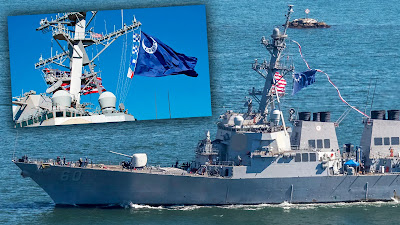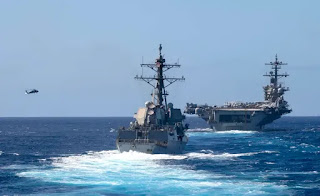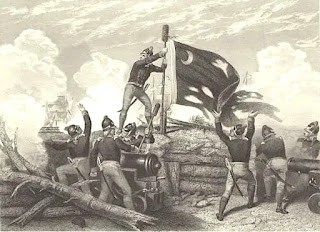25 October 2020: This week was a maritime historical cornucopia given the number of significant historical events that occurred in the history of the United States. On 21 October, we celebrated the 223 anniversary of the of launching of the U.S. FRIGATE (now U.S.S) CONSTITUTION in Boston, Massachusetts where she still floats and occasionally gets underway as America' Ship of State. Then on the 25th, we celebrated the largest fleet battle and the tragic death of Admiral Lord Nelson at Trafalgar in 1805. Those among you who have studied some history may recall that Nelson, on his flagship HMS VICTORY, led his British fleet into battle against the combined fleets of Spain and France, decimating both. And like Constitution, Victory also lives on in Portsmouth Royal Dockyard, albeit "on the hard" and safely secure in her title of the oldest still commissioned warship in the world. And finally, (as if those two events weren't enough) the U.S. Frigate UNITED STATES, under command of Stephen Decatur, met and defeated the HMS Macedonian in the waters of the eastern Atlantic. To cap off his brilliant victory, Decatur had Macedonian made sea-worthy and then brought his prize into the United States across over 1,000 miles of potentially hostile water. So a big week!
Now, today's story leaps ahead to the 1980's and an amazing vessel/plane resting on the shore of the Caspian Sea. From CNN:
~~~~~~~~~~~~~~~~~~~~~~~~~~~
Beached on the western shores of the Caspian Sea, it looks like a colossal aquatic beast -- a bizarre creation more at home in the deep than above the waves. It certainly doesn't look like something that could ever fly.
But fly it did -- albeit a long time ago.
After lying dormant for more than three decades, the Caspian Sea Monster has been on the move again. One of the most eye-catching flying machines ever built, it's completing what could be its final journey.
In July of this year after 14 hours at sea, a flotilla of three tugs and two escort vessels maneuvered slowly along the shores of the Caspian Sea to deliver their bulky special cargo to its destination, a stretch of coast near Russia's southernmost point.
It's here, next to the ancient city of Derbent, in Russia's republic of Dagestan, that the 380-ton "Lun-class Ekranoplan" has found its new, and most likely definitive, home.
The last of its breed to sail the waters of the Caspian, "Lun" was abandoned after the 1990s collapse of the Soviet Union, condemned to rust away at Kaspiysk naval base, some 100 kilometers (62 miles) up the coast from Derbent.
But before it could fade into oblivion, it's been rescued thanks to plans to make it a tourist attraction right at a time when this unusual travel concept could be poised to make a comeback.
Ground Effect Vehicles, also known as "ekranoplans," are a sort of hybrid between airplanes and ships. They move over water without actually touching it.
The International Maritime Organization classifies them as ships, but, in fact, they derive their unique high-speed capabilities from the fact that they skim the surface of the water at a height of between one and five meters (three to 16 feet).
They take advantage of an aerodynamic principle called "ground effect."
This combination of speed and stealth -- their proximity to the surface while flying makes them difficult to detect by radar -- got the attention of the Soviet military, which experimented with several variants of the concept during the Cold War.
Their deployment on the vast inland body of water between the Soviet Union and Iran led to them acquiring the nickname "Caspian Sea Monster."
The "Lun" ekranoplan was one of the last designs to come out of the Soviet ground effect vehicle program. Longer than an Airbus A380 superjumbo and almost as tall, despite its size and weight, the Lun was capable of reaching speeds of up to 550 kilometers per hour (340 mph) thanks to eight powerful turbofans located on its stubby wings.
This formidable machine was even able to take off and land in stormy conditions, with waves of up to two and a half meters. Its intended mission was to conduct lightning sea-borne attacks with the six anti-ship missiles it carried in launch tubes placed at the top of its hull.
The ekranoplan that has been moved to Derbent is the only one of its class ever completed and entered service in 1987.
A second Lun, unarmed and assigned to rescue and supply missions, was at an advanced state of completion when, in the early 1990s, the whole program was canceled and the existing Lun withdrawn from service.
After 30-plus years of inaction, getting this sea beast back on the move was no easy task, requiring the assistance of rubber pontoons and a carefully coordinated choreography involving several vessels.
"Lun" will be the star of Derbent's planned Patriot Park, a military museum and theme park that will display different sorts of Soviet and Russian military equipment.
Construction of the park is expected to start later in 2020. For the time being, Lun will sit alone on the beach.
It looks set to become a new highlight for visitors to Derbent. The city claims to be the oldest continuously inhabited settlement in Russian territory. Its citadel and historical center have been designated by UNESCO as World Heritage Sites.
`~~~~~~~~~~~~~~~
An interesting tale and one not generally known. A pretty amazing craft. We can only imagine what it must have been like to fly one!
Until next time,
Fair Winds,
Old Salt






